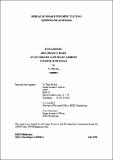| Abstract | The Australian sugar industry invests millions of dollars annually on sugarcane breeding programs and associated research. Improved selection efficiency as a result of more accurate estimates of commercial cane sugar (ccs) will greatly enhance returns on this investment. Sugarcane breeding and research programs use hand cut sound whole-stalk samples for determination of ccs and other quality components. Whole-stalk provide a biased sample of the material harvested for milling from experimental plots as they are free from extraneous matter and inferior quality cane. The small mill has low efficiency of juice extraction from whole-stalks, extracting only 26-50% of the absolute juice, and this also leads to bias. The bias in processing billet and whole-stalk samples through a small laboratory roller mill and a hydraulic press with higher levels of juice extraction was quantified in experiments at Tully, Burdekin, Bundaberg and Broadwater. The use of sound whole-stalk samples processed through a small laboratory roller mill with low levels of juice extraction seriously biases the accuracy of estimation of sugar content of sugarcane. Bias for whole-stalk samples was quantified and compared with samples of commercially harvested cane in selection experiments at Broadwater and Tully. A bias of more than seven units of ccs was measured in badly lodged, heavily suckered and deteriorated cane harvested green at Tully. A bias of three units of ccs was less serious in burnt cane at Broadwater. Despite these biases and the inaccurate over-estimation of sugar content of harvested cane from experimental plots, sound whole-stalk samples are usually adequate for ranking of clones for selection purposes. However, billet samples provide a far more accurate estimate of commercial ccs and are preferable for predicting the true responses of commercial varieties to various agronomic treatments. There is a need for an automated method of sampling harvested cane from experimental plots for the unbiased collection of samples. The use of unbiased samples should greatly improve the accuracy of ccs assessment and provide a direct measure of the commercial value of the harvested material. Automated sampling of billets should be more efficient than the manual collection of whole-stalk samples and, with appropriate strategies, will result in greater genetic gain for sugar content. The acquisition of an automated billet sampler will greatly improve labour use efficiency and workplace safety. Information collected in project BS118S has resulted in SRDC funding project BS156S and the construction of an automated sampler. |

